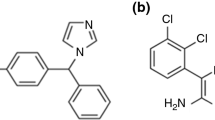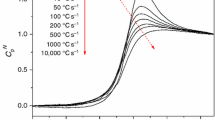Abstract
Purpose. The purpose of this study was to estimate the activation energy at the glass transition temperature (and the fragility index) of amorphous indomethacin from the influence of heating rate on the features of the relaxation peaks obtained by thermally stimulated depolarization currents (TSDC) and to compare the obtained results with those obtained by other procedures based on TSDC data.
Methods. The glass transition temperature region of amorphous indomethacin was characterized at different heating rates by TSDC in a way similar to that used to determine the kinetics of the glass transition relaxation by differential scanning calorimetry. The features of a thermal sampled TSDC peak, namely the temperature location and the intensity, depend on the heating rate.
Results. The activation energy for structural relaxation (directly related to glass fragility) was estimated from the heating rate dependence of the TSDC peak location, T m, and of the maximum intensity of the TSDC peak, I(T m).
Conclusions. The methods for determining the activation energy for structural relaxation and fragility of indomethacin from TSDC data obtained with different heating rates were compared with other procedures previously proposed. TSDC, which is not a very familiar technique in the community of pharmaceutical scientists, proved to be a very convenient technique to study molecular mobility and to determine the fragility index in glass-forming systems. The value of ∼60 appears as a reasonable value of the fragility index of indomethacin.
Similar content being viewed by others
REFERENCES
B. C. Hancock and G. Zografi. Characteristics and significance of the amorphous state in pharmaceutical systems. J. Pharm. Sci. 86:1–12 (1997).
D. Q. M. Craig, P. G. Royal, V. L. Kett, and M. L. Hopton. The relevance of amorphous state to pharmaceutical dosage forms: Glassy drugs and freeze dried systems. Int. J. Pharm. 179:179–207 (1999).
S. L. Shambling, X. Tang, L. Chang, B. C. Hancock, and M. J. Pikal. Characterization of the time scales of molecular motion in pharmaceutically important glasses. J. Phys. Chem. B 103:4113–4121 (1999).
S. L. Shambling, B. C. Hancock, Y. Dupuis, and M. J. Pikal. Interpretation of relaxation time constants for amorphous pharmaceutical systems. J. Pharm. Sci. 89:417–427 (2000).
P. G. Debenedetti. Metastable Liquids: Concepts and Principles, Princeton University Press, Princeton, New Jersey, 1996.
R. Bohmer and C. A. Angell, Local and global relaxations in glass-forming materials. In R. Richert and A. Blumen (eds.), Disorder Effects on Relaxational Processes, Springer-Verlag, Berlin, Heidelberg, 1994.
A. Hofmann, F. Kremer, E. W. Fischer, and A. Schonhals, The scalling of the ?-and ?-relaxation in low molecular weight and polymeric glass-forming systems. In R. Richert and A. Blumen (eds.). Disorder Effects on Relaxational Processes, Springer-Verlag, Berlin, Heidelberg, 1994.
C. T. Moynihan, A. J. Esteal, J. Wilder, and J. Tucker. Dependence of the glass transition temperature on heating and cooling rates. J. Phys. Chem. 76:2673–2677 (1974).
O. Bustin and M. Descamps. Slow structural relaxations of glass-forming maltitol by modulated DSC calorimetry. J. Chem. Phys. 110:10982–10992 (1999).
N. T. Correia, C. Alvarez, J. J. Moura Ramos, and M. Descamps. Glass transition relaxation and fragility in the molecular glass forming m-toluidine: A study by thermally stimulated depolarization currents. J. Chem. Phys. 113:3204–3211 (2000).
V. Adronis and G. Zografi. Molecular mobility of supercooled amorphous indomethacin, determined by dynamical mechanical analysis. Pharm. Res. 14:410–414 (1997).
V. Adronis and G. Zografi. The molecular mobility of supercooled amorphous indomethacin as a function of temperature and relative humidity. Pharm. Res. 15:835–842 (1998).
R. He and D. Q. M. Craig. An investigation into the thermal behavior of an amorphous drug using low frequency dielectric spectroscopy and modulated temperature differential scanning calorimetry. J. Pharm. Pharmacol. 53:41–48 (2001).
N. T. Correia, J. J. Moura Ramos, M. Descamps, and G. Collins. Molecular mobility and fragility in indomethacin: A thermally stimulated depolarization currents study. Pharm. Res. 18:1767–1774 (2001).
V. Adronis and G. Zografi. Crystal nucleation and growth of indomethacin polymorphs from the amorphous state. J. Non-Cryst. Solids 271:236–248 (2000).
N. T. Correia, C. Alvarez, J. J. Moura Ramos, and M. Descamps. The ?-? branching in D-sorbitol as studied by thermally stimulated depolarization currents (TSDC). J. Phys. Chem. B 105:5663–5669 (2001).
R. Chen and Y. Kirsch. Analysis of Thermally Stimulated Processes, Pergamon Press, Oxford, 1981.
R. Bohmer, K. L. Ngai, C. A. Angell, and D. J. Plazek, Nonexponential relaxations in strong and fragile glass formers. J. Chem. Phys. 99:4201–4209 (1993).
N. T. Correia, C. Alvarez, J. J. Moura Ramos, and M. Descamps. Molecular motions in molecular glasses as studied by thermally stimulated depolarization currents (TSDC). Chem. Phys. 252:151–163 (2000).
K. J. Crowley and G. Zografi. The use of thermal methods for predicting glass-former fragility. Thermochimica Acta 380:79–93 (2001).
J. J. Moura Ramos and N. T. Correia. The Deborah number, relaxation phenomena and thermally stimulated currents. Phys. Chem. Chem. Phys. 3:5575–5578 (2001).
Author information
Authors and Affiliations
Corresponding author
Rights and permissions
About this article
Cite this article
Moura Ramos, J.J., Correia, N.T., Taveira-Marques, R. et al. The Activation Energy at T g and the Fragility Index of Indomethacin, Predicted from the Influence of the Heating Rate on the Temperature Position and on the Intensity of Thermally Stimulated Depolarization Current Peak. Pharm Res 19, 1879–1884 (2002). https://doi.org/10.1023/A:1021405927463
Issue Date:
DOI: https://doi.org/10.1023/A:1021405927463




